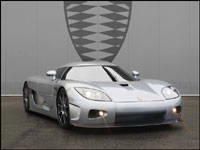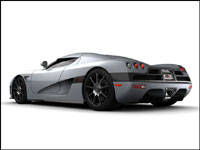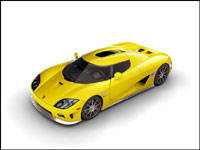Norse Exotic to join Elite Automotive Rank in AmericaLet's face it; we don't have enough supercars here in North America.While
 |
| The Koenigsegg CCX. It's definitely not your Uncle Olaf's Volvo. (Photo: Koenigsegg Automotive AB) |
we get a few of the heavy-hitting all-stars like the FerrariEnzo, Porsche Carrera GT and the Mercedes-McLaren SLR, we're consistentlymissing out on some of the machines that come out of small, almostcoachwork-style firms. We don't get Ascaris, Spykers, Nobles or thebeautiful Paganis, and we certainly don't get Sweden's only supercar,the difficult to pronounce but brutally fast Koenigsegg. Prior to theBugatti Veyron (also unavailable in North America) the Koenigsegg CCR heldthe title of the world's fastest automobile, with a top speed of morethan 345.4 km/h (245 mph). The only way to have this truly desirablevehicle on North American soil was either on your computer screen orTV; that was until this year's Geneva motor show, where the brandunveiled the heavily reworked CCX, a version of the CCR,tailor-modified to North American rules and tastes.
The
 |
| For a company that consists of just 30 people, the US-bound CCX was a heavy investment. (Photo: Koenigsegg Automotive AB) |
reason thatmost of the world's great supercars or sports cars don't cross theAtlantic or Pacific Ocean is because they fail to meet a wide varietyof federal standards, ranging from safety, to bumpers and emissions. TheU.S. government requires that all cars sold there must have an airbag, beable to meet front side and rear impact tests, have bumpers that canwithstand a 2.5 mph (4 km/h) knock, and be able to pass the EPA'sstringent emission and smog controls. Canada's rules are even more difficult to meet, making it the heaviest regulated of any country in the world - at least with regards to the automotive sector. This is very different from thestate of things in Europe, where low-volume production runs and kit-carsbypass many of the rules and regulations of mass volume passenger vehicles,explaining why the Morgans and Caterhams of the world are still aliveand kicking despite the use of outdated engines and underpinnings thatare of questionable structural integrity.
Wishing to get in ona slice of the U.S. supermarket, Koenigsegg decided that it was worth theeffort and the time to prepare the CCR for its big journey to America,but, like anyone preparing for a major trip to a far-off land, itneeded an overhaul before it was granted a visa and passport.
Californiais one of the hottest markets in North America for
 |
| Should be right at home on Sunset Boulevard. (Photo: Koenigsegg Automotive AB) |
supercars. Out ofall the states, it's home to more movie stars, more musicartists, more media moguls, and generally more rich and famouspeople than anywhere else, making it America's supercarcapital. But, as the saying goes, "there's no free lunch,"; Californiais one of the most difficult states to gain access to for any kind ofautomobile, as it has some of the world's strictest emissions standards.In order to make the cut, without crippling the CCX's 806-horsepower rating,Koenigsegg had to significantly modify the engine and then retrofit avastly more expensive and complex exhaust system. Koenigsegg alsomodified the engine to run on North American 'Premium' fuels, whichhave an octane rating of 91, a value significantly lower than theregular grade of gasoline in Europe.





